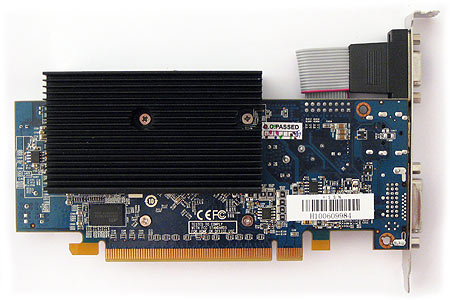Radeon HD 5550 And 5570: Pumped Up With GDDR5
AMD quietly introduced its new Radeon HD 5550 and prepped the Radeon HD 5570 GDDR5 to follow. We examine the performance of these two stealth-launched models to see if they have what it takes to replace a couple of power contenders in the sub-$100 market.
HIS Radeon HD 5550 DDR3 And GDDR5
AMD told us that Hightech Information System's (HIS) Radeon HD 5550 models are based closely on the reference card, so this makes them a good place to start. First, the HIS Radeon HD 5550 DDR3:
Indeed, the DDR3 version of the Radeon HD 5550 appears to be a carbon copy of the Radeon HD 5570 DDR3--the half-height circuit board looks identical. HIS gives this card a core clock speed in line with AMD’s reference specification of 550 MHz, but the memory is clocked at 650 MHz--150 MHz below the reference memory specification of 800 MHz. The memory is receptive to tweaking though, and we’re raising it to 800 MHz in order to demonstrate reference Radeon HD 5550 DDR3 performance in our benchmarks.
HIS uses a passive cooling block on its Radeon HD 5550 DDR3, and as the temperature benchmarks will show, the cooler does a fine job. The modest 550 MHz core clock speed of the Radeon HD 5550 helps in this respect. Note that this card has no CrossFire fingers, as multi-card configurations in the entry-level space are handled through the PCI Express (PCIe) bus.
The HIS Radeon HD 5550 DDR3 card has no DisplayPort output, so triple-monitor Eyefinity is not an option. The card does have a DVI, an HDMI, and a VGA output, though.
This budget bundle includes two half-height bezels, a driver CD, and an installation manual. While there is no bundled software, there is an included 10% off coupon for Battlefield: Bad Company 2 and a 50% off coupon for ArcSoft TotalMedia Theater DVD playback software.
Overclocking
In order to provide a meaningful overclock, we want an active cooler on the Radeon HD 5550 DDR3 instead of HIS’ passive model, so we’re installing Evercool's Turbo 2 to the GPU.
Get Tom's Hardware's best news and in-depth reviews, straight to your inbox.
The HIS Radeon HD 5550 DDR3 card has a 700 MHz core and a 950 MHz memory limit in the Catalyst Control Center’s (CCC) Overdrive panel. We usually use MSI’s Afterburner utility to open up higher potential overclocks, but in this case, Afterburner caps out at a disappointing 715 MHz core and 850 MHz memory limit. The card is able to handle the maximum 700 MHz core and 950 MHz memory limits without protest.
HIS Radeon HD 5550 GDDR5
Now, let’s look at HIS’ GDDR5 version of the Radeon HD 5550:
Just as the Radeon HD 5550 DDR3 card is based on the DDR3 Radeon HD 5570 reference design, so too is the GDDR5 version of the Radeon HD 5550 based on the Radeon HD 5670. There are a few things changed, and it appears that there are a couple of missing MOFSETs on the card, but the circuit board itself looks just like a reference Radeon HD 5670. The 550 MHz core and 1000 MHz GDDR5 memory clocks on this HIS model are identical to AMD’s reference specifications.
This HIS card also uses a passive cooler, which is somewhat different than the wrap-around model on the DDR3 version of the card. Once again, there are no CrossFire fingers on this board, although the feature does work by communicating through the PCIe bus.
Unlike the HIS Radeon HD 5570 GDDR5 sample we have, the HIS Radeon HD 5550 GDDR5 card is not equipped with a DisplayPort output, and therefore triple-monitor Eyefinity is not a possibility. The card has a DVI, an HDMI, and a VGA output instead.
The bundle comes only with a driver CD and an installation manual--there is no DVI-to-VGA converter for analog display users. As with the DDR3 version of the HIS Radeon HD 5550, there are vouchers for discounts on Battlefield: Bad Company 2 and ArcSoft TotalMedia Theater.
Current page: HIS Radeon HD 5550 DDR3 And GDDR5
Prev Page The Radeon HD 5550 Architecture Next Page PowerColor PCS+ HD 5550 GDDR5Don Woligroski was a former senior hardware editor for Tom's Hardware. He has covered a wide range of PC hardware topics, including CPUs, GPUs, system building, and emerging technologies.








